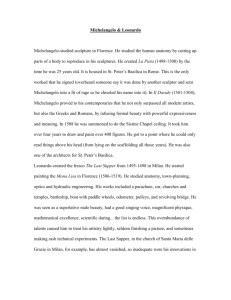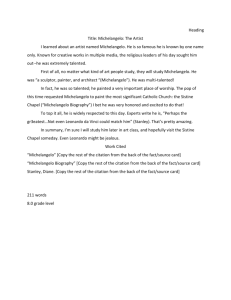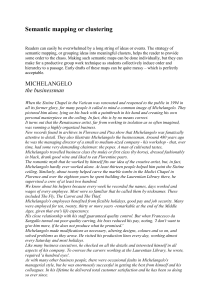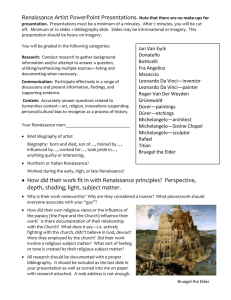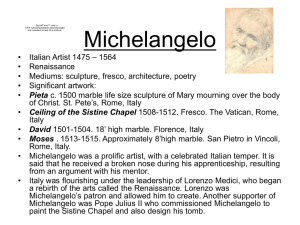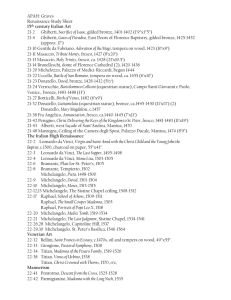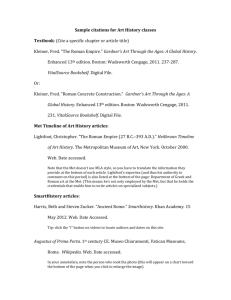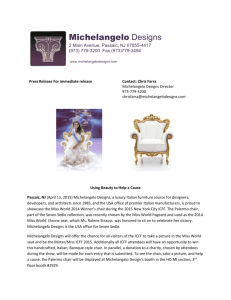Michelangelo, sculpture
advertisement
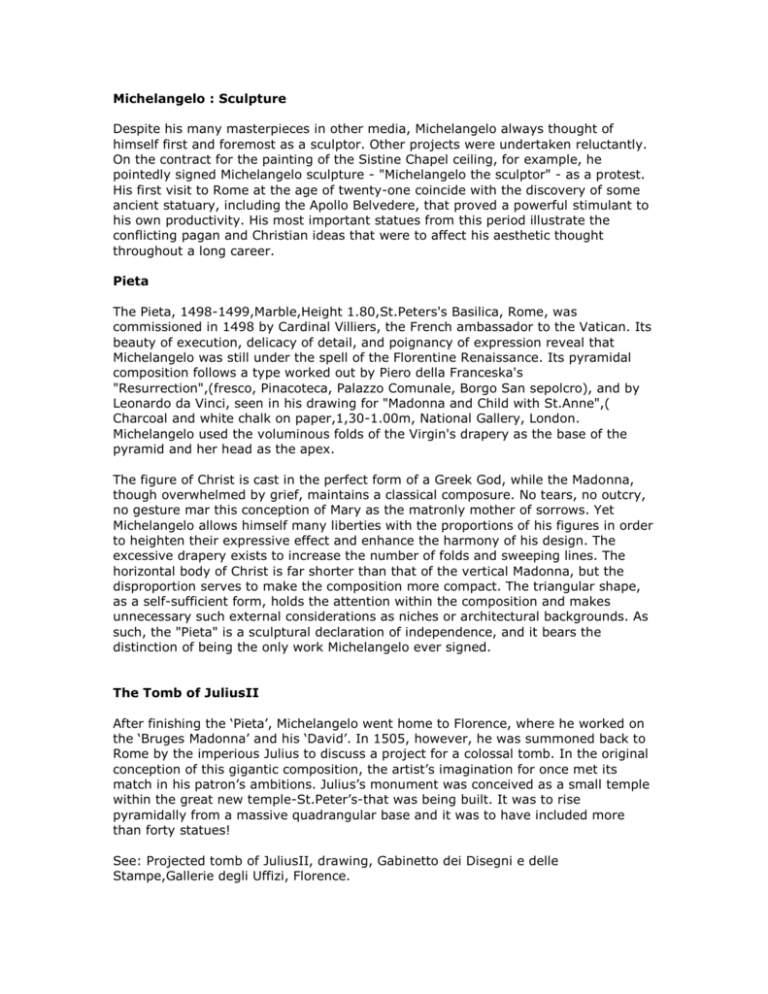
Michelangelo : Sculpture Despite his many masterpieces in other media, Michelangelo always thought of himself first and foremost as a sculptor. Other projects were undertaken reluctantly. On the contract for the painting of the Sistine Chapel ceiling, for example, he pointedly signed Michelangelo sculpture - "Michelangelo the sculptor" - as a protest. His first visit to Rome at the age of twenty-one coincide with the discovery of some ancient statuary, including the Apollo Belvedere, that proved a powerful stimulant to his own productivity. His most important statues from this period illustrate the conflicting pagan and Christian ideas that were to affect his aesthetic thought throughout a long career. Pieta The Pieta, 1498-1499,Marble,Height 1.80,St.Peters's Basilica, Rome, was commissioned in 1498 by Cardinal Villiers, the French ambassador to the Vatican. Its beauty of execution, delicacy of detail, and poignancy of expression reveal that Michelangelo was still under the spell of the Florentine Renaissance. Its pyramidal composition follows a type worked out by Piero della Franceska's "Resurrection",(fresco, Pinacoteca, Palazzo Comunale, Borgo San sepolcro), and by Leonardo da Vinci, seen in his drawing for "Madonna and Child with St.Anne",( Charcoal and white chalk on paper,1,30-1.00m, National Gallery, London. Michelangelo used the voluminous folds of the Virgin's drapery as the base of the pyramid and her head as the apex. The figure of Christ is cast in the perfect form of a Greek God, while the Madonna, though overwhelmed by grief, maintains a classical composure. No tears, no outcry, no gesture mar this conception of Mary as the matronly mother of sorrows. Yet Michelangelo allows himself many liberties with the proportions of his figures in order to heighten their expressive effect and enhance the harmony of his design. The excessive drapery exists to increase the number of folds and sweeping lines. The horizontal body of Christ is far shorter than that of the vertical Madonna, but the disproportion serves to make the composition more compact. The triangular shape, as a self-sufficient form, holds the attention within the composition and makes unnecessary such external considerations as niches or architectural backgrounds. As such, the "Pieta" is a sculptural declaration of independence, and it bears the distinction of being the only work Michelangelo ever signed. The Tomb of JuliusII After finishing the ‘Pieta’, Michelangelo went home to Florence, where he worked on the ‘Bruges Madonna’ and his ‘David’. In 1505, however, he was summoned back to Rome by the imperious Julius to discuss a project for a colossal tomb. In the original conception of this gigantic composition, the artist’s imagination for once met its match in his patron’s ambitions. Julius’s monument was conceived as a small temple within the great new temple-St.Peter’s-that was being built. It was to rise pyramidally from a massive quadrangular base and it was to have included more than forty statues! See: Projected tomb of JuliusII, drawing, Gabinetto dei Disegni e delle Stampe,Gallerie degli Uffizi, Florence. When Julius died in 1513, only parts of the project had been finished, and a new contract with his heirs had to be negotiated. Further revisions were made later, each reducing the proportions of the project and eliminating more of the unfinished statues. In its final form 1545, the monument had shrunk to the relatively modest wall tomb now in the aisle of the church of San Pietro in Vincoli. Tombs of the popes, like the triple tiaras with which they were crowned, were traditionally in three rising zones, symbolizing earthly existence, death, and salvation. For the original project, Michelangelo translated these divisions into Neoplatonic terms representing the successive stages of the liberation of the soul from its bodily prison. For the final project, the monument lapsed into more traditional stages. In the original scheme, the lowest level was to have figures symbolizing those who rise above the bonds of matter. This idea was retained in some of the later revisions, and six of the so-called Slaves or Captives and so-called Victory survive in various stages of completion. On the second level of the original project were to have been placed heroic figures of the leaders of humanity, those individuals who pointed the way toward the divine goal of reunion with God. Moses and St. Paul were to represent the old and new law, while Rachel and Leah would personify the active and contemplative ways of life. Of these, only the Moses was finished by Michelangelo himself. The three figures that date from the years 1513 to 1516, when Leo X was pope, are the two “Slaves” now in the Louvre and the “Moses”. The “Bound Slave”(1513-16, marble, height 2’30m, Louvre, Paris) is the more nearly finished of the two, and it seems to represent a sleeping adolescent tormented by a dream rather than the “dying captive” it is sometimes called. The imprisoned soul, tortured by the memory of its divine origin, has found momentary peace in sleep. The cloth bands by which the figure is bound are only symbolic, since Michelangelo is not concerned with the external aspect of captivity but rather with the internal torment. It is the tragedy of the human race, limited by time but troubled by the knowledge of eternity; mortal but with a vision of immortality; bound by the weight of the body yet dreaming of a boundless freedom. This tragedy of the tomb was understood only too well by Michelangelo himself, who had the conception of his great project in mind but was doomed to see only a few fragments of his dream completed. Figures such as the “Slaves’ and the “Victory’ that he planned were associated with the triumphal arches as well as with the mausoleums and sarcophagi of ancient Rome. The similarity between the “Bound Slave” and the younger son in the 2nd-century B.C.”Laocoon Group”by Agesander, Athenodorus, and Polydorus of Rhodes.Marble, height 2.50m, Vatican Museums, Rome, has aptly been pointed out. The Platonic idea of the human soul confined in the bonds of flesh was continued in a later version of the tomb. The imprisonment of the spirit by matter in these ”Captives” is all but complete. Unconscious, locked in their stone wombs, they struggle and writhe to emerge from their material bondage. Their unfinished state gives an interesting glimpse into Michelangelo’s methods, which were similar to those of relief sculpture. The statue, to Michelangelo, was a potential form hidden in the block of marble awaiting the hand of the master sculptor in order to be born. “The greatest artist has no single concept which a rough marble block does not contain already in its core…”,wrote Michelangelo in a sonnet. The artist-creator, he continues, must discover,” concealed in the hard marble of the north, the living figure one has to bring forth. (The less of stone remains, the more that grows.) The Neo-platonic implication is that the soul is still entombed in the body and can only be perfected into pure being by the hand of a higher creative power. The sculpture of Moses 91513-15, height 2.60m,San Pietro in Vincoli, Rome. Moses is the statue completed entirely by Michelangelo’s hand to find its place in the finished tomb. Both Julius II and Michelangelo possessed the quality of “Terribilita”, or “awesomeness”, that is embodied in this figure. Julius was known as “il papa terribile”, meaning the “forceful” or the “powerful pope”, imbued with fear of the Lord. Michelangelo conceived his Moses as the personification of a powerful will, and partially as an idealized portrait of the determined Julius who, as the formulator of a code of Church laws, had something in common with the ancient Hebrew law-giver. Moses is further portrayed as the personification of the elemental forces. He is the human volcano about to erupt with righteous wrath, the calm before a storm of moral indignation, the dead center of a hurricane of emotional fury, the messenger of those thunderous “Thou Shalt Nots” of the Ten Commandments, the man capable of ascending Mt. Sinai to talk with God and coming back down to review all humanity from the seat of judgment. The smoldering agitation revealed through the drapery, the powerful musculature of the arms, the dominating intelligence of the face, the fiery mood, and the twisting of the body in the act of rising are characteristic of Michelangelo’s style. An interesting detail is is the carved irises of the eyes, found earlier in his ‘David’ which Michelangelo did to express a look of fixed determination. When he wanted to convey the qualities of dreaminess, gentleness, and resignation, as in his Madonnas, he left the eyes untouched. The curious horns on Moses’ head were an iconographical tradition from medieval times. They stem from a mistranslation in the Latin version of the Old Testament, which should have read “rays of light”. Michelangelo worked at the time when many of the most outstanding examples of antique statuary were being unearthed and admired. Inevitably this led to critical comparisons. Michelangelo like the Greco- Roman artists, saw men and women as the lords of creation, but their natural environment was always a matter of indifference to him. His early art especially was an affirmation to the supreme place of humanity in the universal scheme of things. That world was populated by godlike beings at the peak of their physical power, full of vitality, creatively active, and affirmatively self-confident. As Michelangelo’s art matured, his men and women were beset with quite unclassical tensions, doubts and conflicts. Unlike the statues of antiquity, his figures, when they come to grips with fate, are armed with mental and moral powers that imply the hope of ultimate victory. Having thus surpassed the art of the ancients as well as that of his own time, not only by his technical mastery but by his expressive power, he came to be regarded by his contemporaries with awe. Vasari, his biographer, wrote: “ The man who bears the palm of all the ages, transcending and eclipsing all the rest, is the divine Michelangelo Buonarroti, who is supreme not in one art only but in all three at once.” History has since had no reason to reverse this judgment.
